

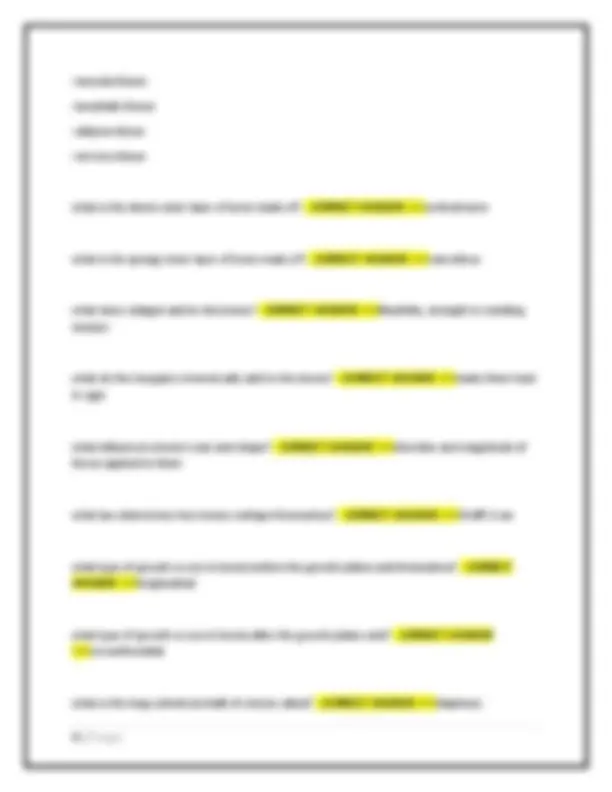
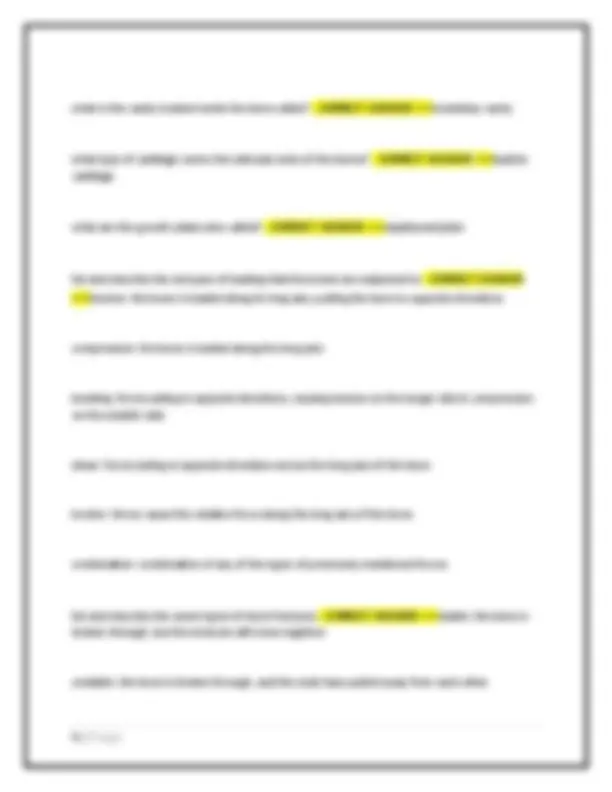
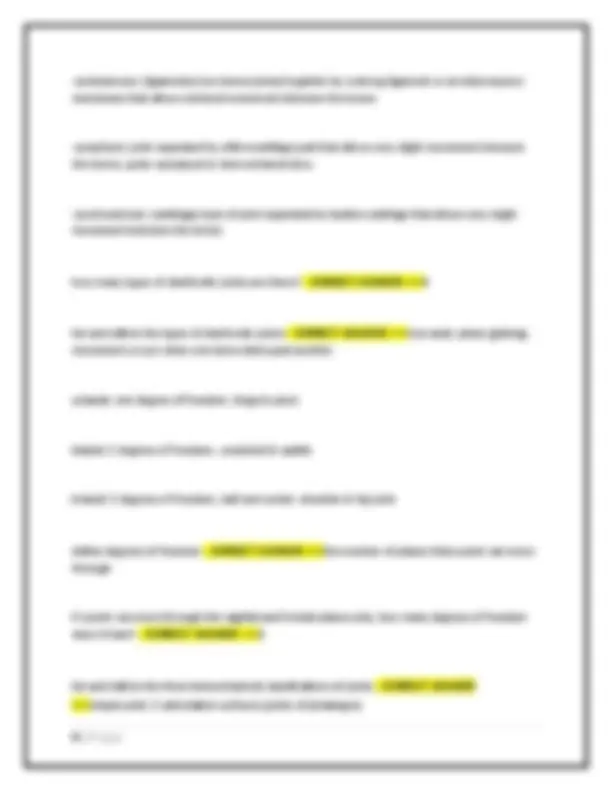
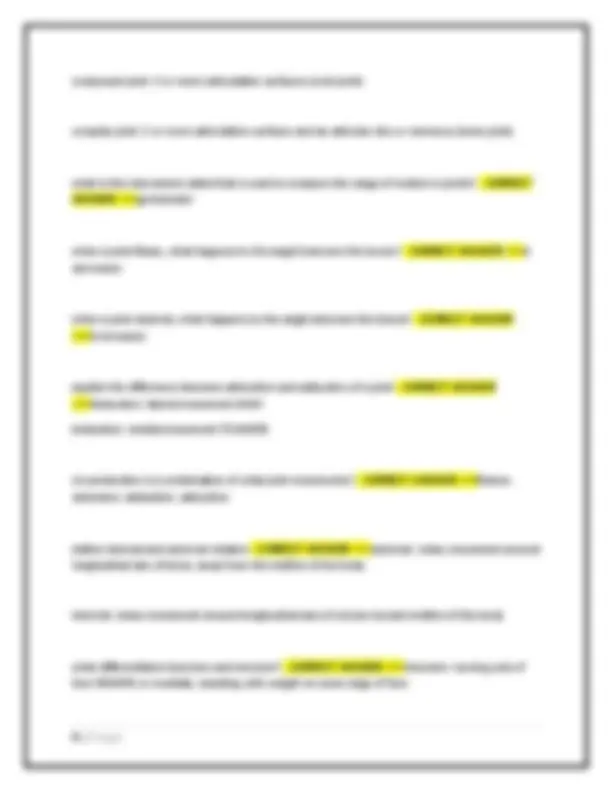
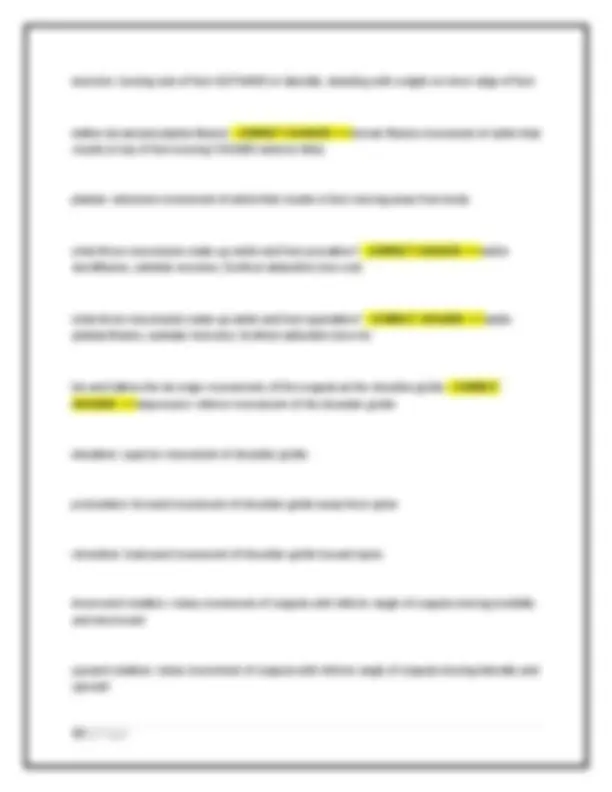
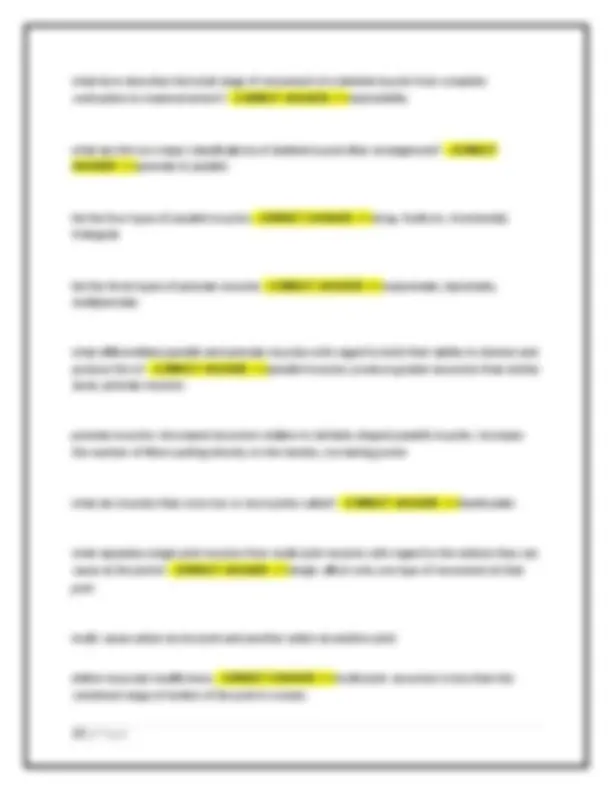
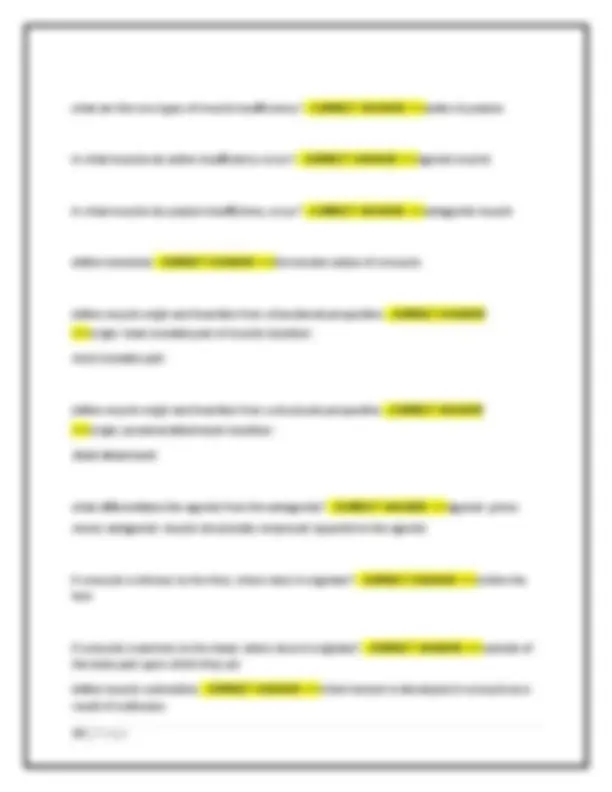
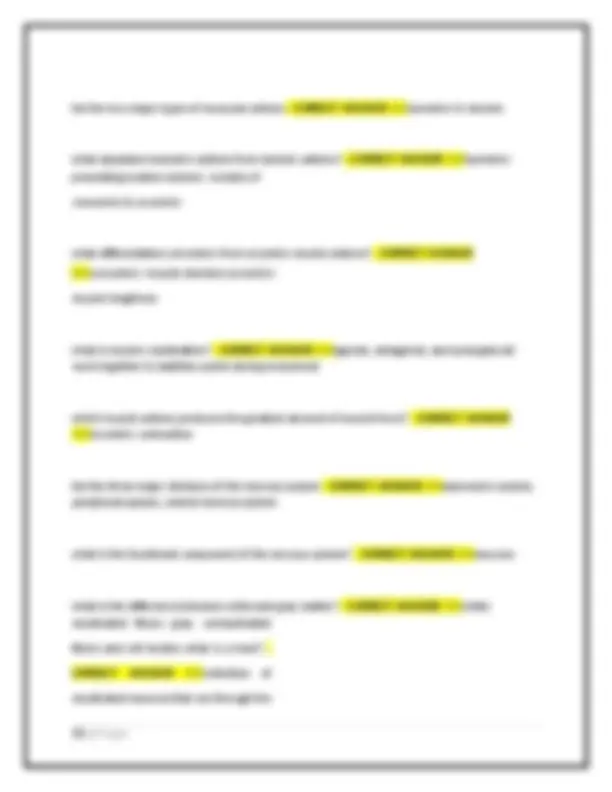


Study with the several resources on Docsity

Earn points by helping other students or get them with a premium plan


Prepare for your exams
Study with the several resources on Docsity

Earn points to download
Earn points by helping other students or get them with a premium plan
Community
Ask the community for help and clear up your study doubts
Discover the best universities in your country according to Docsity users
Free resources
Download our free guides on studying techniques, anxiety management strategies, and thesis advice from Docsity tutors
KHP 3352 FINAL ACTUAL EXAM (NEXT GENERATION) COMPLETE 200 QUESTIONS & CORRECT ANSWERS WITH RATIONALES GRADED A+
Typology: Exams
1 / 17

This page cannot be seen from the preview
Don't miss anything!










define kinesiology - CORRECT ANSWER >>> study of human motion or movement what four fields is kinesiology a combo of? - CORRECT ANSWER >>> anatomy, physiology, physics, geometry what three areas of study does human kinesiology concern itself with? **- CORRECT ANSWER
** mechanics, musculoskeletal anatomy, neuromuscular physiology what is the difference between Anatomic and Fundamental position? **- CORRECT ANSWER ** Anatomic: Reference position Fundamental: Palms facing body if X is superior to Y, is X above or below Y? - CORRECT ANSWER >>> above if X is distal to Y, is X closer to the midline of the body or further away from it than Y? - CORRECT ANSWER >>> further describe the difference between lying prone and lying supine - CORRECT ANSWER >>> Prone: laying on stomach Supine: laying on back how many major planes of motion are there? - CORRECT ANSWER >>> 3
what are the major planes of motion? - CORRECT ANSWER >>> sagittal, frontal, transverse how many minor planes of motion are there? - CORRECT ANSWER >>> 2 what are the minor planes of motion? - CORRECT ANSWER >>> high and low diagonal how many major axes of rotation are there? - CORRECT ANSWER >>> 3 what are the major axes of rotation? - CORRECT ANSWER >>> rotation of frontal, sagittal & polar axis is the axis of rotation perpendicular or parallel to its plane of motion? **- CORRECT ANSWER
** perpendicular jumping jacks are an example of exercises that move through which plane? **- CORRECT ANSWER ** frontal-coronal sit ups are an example of exercises that move through which plane? **- CORRECT ANSWER ** sagittal rotating the spine to face left or right is an example of a movement that moves through which plane? - CORRECT ANSWER >>> transverse an overhand baseball pitch is an example of a movement that moves through which plane? - CORRECT ANSWER >>> high diagonal
what is the cavity located inside the bone called? - CORRECT ANSWER >>> medullary cavity what type of cartilage covers the articular ends of the bones? - CORRECT ANSWER >>> hyaline cartilage what are the growth plates also called? - CORRECT ANSWER >>> epiphyseal plate list and describe the six types of loading that the bones are subjected to **- CORRECT ANSWER
** tension: the bone is loaded along its long axis, pulling the bone in opposite directions compression: the bone is loaded along the long axis bending: forces acting in opposite directions, causing tension on the longer side & compression on the smaller side shear: forces acting in opposite directions across the long axis of the bone torsion: forces cause the rotation force along the long axis of the bone combination: combination of any of the types of previously mentioned forces
list and describe the seven types of bone fractures - CORRECT ANSWER >>> stable: the bone is broken through, but the ends are still close together unstable: the bone is broken through, and the ends have pulled away from each other
define an articulation - CORRECT ANSWER >>> connection of bones at a joint, usually to allow movement between surfaces of bones what distinguishes joints and articulations? - CORRECT ANSWER >>> a joint can have several articulations, such as the knee list and define the three classifications of joints: - CORRECT ANSWER >>> structural classification: determines by the structures located between them functional classification: determined by the movement of the joint biomechanics classification: determined by the # of bones meeting at the joint and their biomechanical properties what are the three types of structural joints, and what differentiates them? **- CORRECT ANSWER
** fibrous joint: joined by collagen (sutures of skull) cartilaginous joint: joined by cartilage (manubrio-sternal joint) synovial joint: the bones are not directly joined to each other as in the above examples. instead their articulations are surrounded by a synovial capsule list and describe all of the functional classifications of joints **- CORRECT ANSWER ** *synarthrotic: non-movable. sutures of the skull, gomphosis of the teeth *amphiarthrotic: slightly movable.
** simple joint: 2 articulation surfaces (joints of phalanges)
eversion: turning sole of foot OUTWARD or laterally. standing with weight on inner edge of foot. define dorsal and plantar flexion - CORRECT ANSWER >>> dorsal: flexion movement of ankle that results in top of foot moving TOWARD anterior tibia plantar: extension movement of ankle that results in foot moving away from body. what three movements make up ankle and foot pronation? - CORRECT ANSWER >>> ankle dorsiflexion, subtalar eversion, forefoot abduction (toe-out) what three movements make up ankle and foot supination? - CORRECT ANSWER >>> ankle plantar flexion, subtalar inversion, forefoot adduction (toe-in) list and define the six major movements of the scapula at the shoulder girdle - CORRECT ANSWER >>> depression: inferior movement of the shoulder girdle elevation: superior movement of shoulder girdle protraction: forward movement of shoulder girdle away from spine retraction: backward movement of shoulder girdle toward spine downward rotation: rotary movement of scapula with inferior angle of scapula moving medially and downward upward rotation: rotary movement of scapula with inferior angle of scapula moving laterally and upward
in horizontal abduction, what direction does the arm move with relation to the midline of the body? - CORRECT ANSWER >>> AWAY from the midline in horizontal plane in horizontal adduction, what direction does the arm move with relation to the midline of the body? - CORRECT ANSWER >>> TOWARD midline in horizontal plane describe the difference between pronation and supination at the proximal radioulnar joint - CORRECT ANSWER >>> pronation: palm down supination: palm up is the range of motion of palmar flexion greater or less than dorsiflexion at the wrist? - CORRECT ANSWER >>> less in anatomic position, does reposition of the thumb move it laterally or medially? - CORRECT ANSWER >>> laterally who has the highest prevalence of bursitis among the population? **- CORRECT ANSWER
** athletes - specifically runners what are the causes of osteoarthritis? - CORRECT ANSWER >>> old age, injury, repetitive stress, certain metabolic diseases describe what a joint dislocation is - CORRECT ANSWER >>> joint pulling apart and reducing or preventing contact between articular surfaces list and define the severity classifications of joint sprains - CORRECT ANSWER >>> 3 types Type 1: stretching, small tears Type 2: larger, incomplete tear
what term describes the total range of movement of a skeletal muscle from complete contraction to maximal stretch? - CORRECT ANSWER >>> extensibility what are the two major classifications of skeletal muscle fiber arrangement? - CORRECT ANSWER >>> pennate & parallel list the four types of parallel muscles - CORRECT ANSWER >>> strap, fusiform, rhomboidal, triangular list the three types of pennate muscles - CORRECT ANSWER >>> unipennate, bipennate, multipennate what differentiates parallel and pennate muscles with regard to both their ability to shorten and produce force? - CORRECT ANSWER >>> parallel muscles: produce greater excursion than similar sized, pennate muscles pennate muscles: decreased excursion relative to similarly shaped parallel muscles. increases the number of fibers pulling directly on the tendon, increasing power what are muscles that cross two or more joints called? - CORRECT ANSWER >>> biarticulate what separates single joint muscles from multi-joint muscles with regard to the actions they can cause at the joints? - CORRECT ANSWER >>> single: affect only one type of movement at that joint multi: cause action at one joint and another action at another joint define muscular insufficiency - CORRECT ANSWER >>> multi-joint: excursion is less than the combined range of motion of the joint it crosses
what are the two types of muscle insufficiency? - CORRECT ANSWER >>> active & passive in what muscles do active insufficiency occur? - CORRECT ANSWER >>> agonist muscle in what muscles do passive insufficiency occur? - CORRECT ANSWER >>> antagonist muscle define tenodesis - CORRECT ANSWER >>> the tendon action of a muscle define muscle origin and insertion from a functional perspective **- CORRECT ANSWER
** origin: least movable part of muscle insertion: most movable part define muscle origin and insertion from a structural perspective **- CORRECT ANSWER ** origin: proximal attachment insertion: distal attachment what differentiates the agonist from the antagonist? - CORRECT ANSWER >>> agonist: prime mover antagonist: muscle structurally reciprocal/ opposite to the agonist if a muscle is intrinsic to the foot, where does it originate? - CORRECT ANSWER >>> within the foot if a muscle is extrinsic to the head, where does it originate? - CORRECT ANSWER >>> outside of the body part upon which they act define muscle contraction - CORRECT ANSWER >>> when tension is developed in a muscle as a result of a stimulus
CNS and carry specific information from one area to another describe the difference between efferent and afferent signaling in neurons - CORRECT ANSWER >>> efferent: descend from PNS to CNS afferent: ascend to CNS from PNS which side of the spinal cord do afferent signals travel through? **- CORRECT ANSWER
** posterior root and horn of spinal cord which side of the spinal cord do efferent signal travel through? - CORRECT ANSWER >>> anterior root and horn of spinal cord which tract is responsible for motor control of the trunk muscles? **- CORRECT ANSWER ** anterior corticospinal tract which tract is responsible for motor control of the limb muscles? - CORRECT ANSWER >>> lateral corticospinal tract what is the structure called that results from multiple spinal nerves exiting the spinal column and then fusing together to serve a distinct location in the body? - CORRECT ANSWER >>> plexus what three major ions are important for action potential generation? **- CORRECT ANSWER ** sodium, potassium, calcium define excitation/ contraction coupling - CORRECT ANSWER >>> the process by which action potential is converted into physical movement which of the three major ions are most important for muscular contraction? - CORRECT ANSWER >>> calcium
define dyskinesia - CORRECT ANSWER >>> uncontrollable muscle movements define dystonia - CORRECT ANSWER >>> prolonged contractions in a muscle resulting in tightness or pain define ataxia - CORRECT ANSWER >>> decreased coordination and balance define spasticity - CORRECT ANSWER >>> abnormal muscle tone, maintained contractions that make movement different or painful what is one of the classification scales for nerve injury that we discussed most in class, and how many classifications within that scale are there? - CORRECT ANSWER >>> Sunderland Classification scale